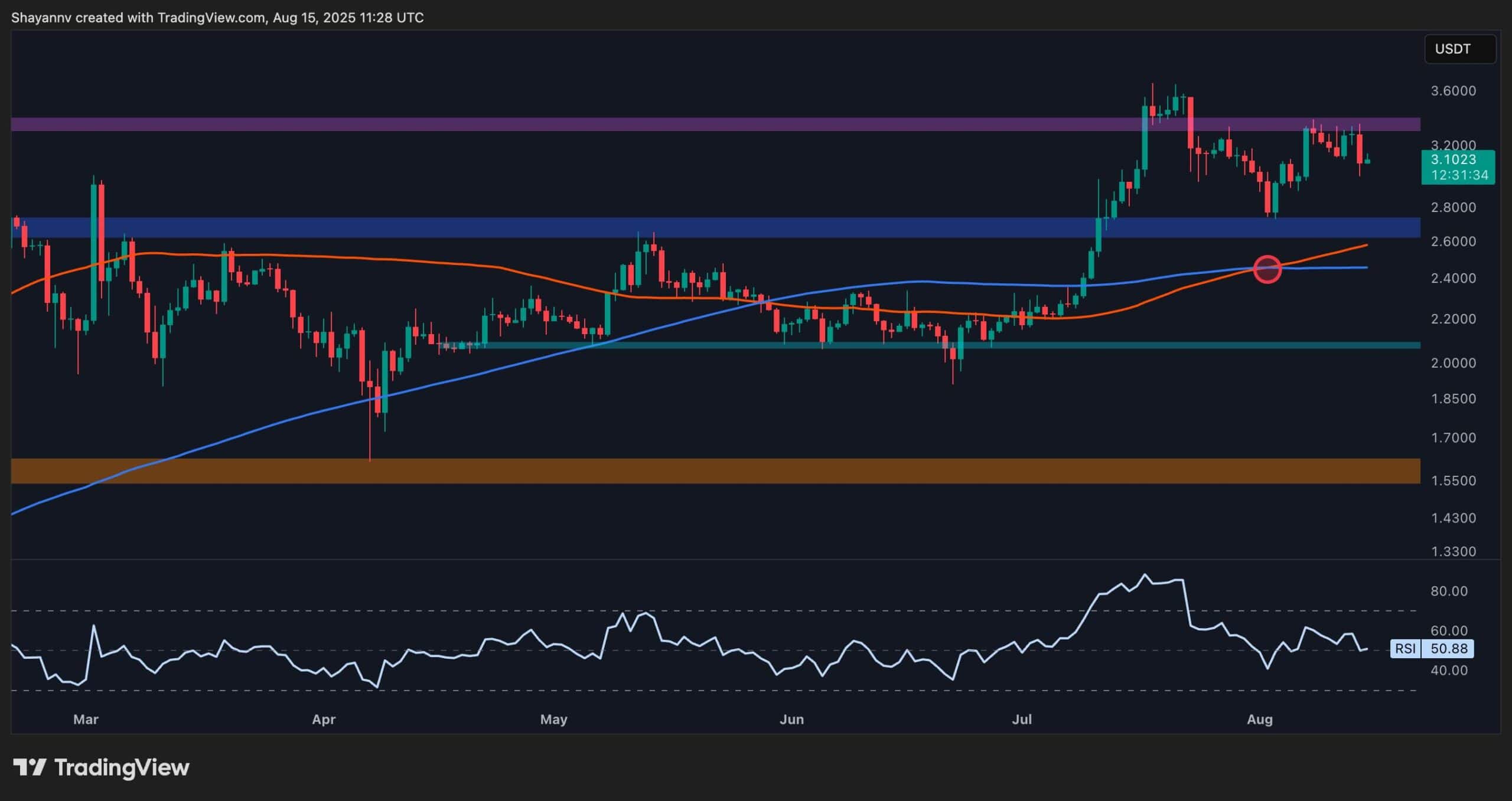Cryptocurrency
The next big leap for Ethereum liquid staking: The staking landscape

Imagine a world where everyone, regardless of their background, can easily access and participate in the revolutionary world of Ethereum. A world where decentralized applications empower individuals, and the potential for innovation knows no bounds. Against a highly equivocal and chaotic macroeconomic landscape, this is the world that the prophets of Ethereum dream of.
But little do they know this world is like an unrealized dream. Why? Let’s dig deeper.
Reflecting on the Ethereum liquid staking landscape
Centralized liquid staking protocols are at the forefront of the liquid staking revolution on Ethereum, and it shouldn’t come as a surprise. Why? Because they are highly scalable — thanks to the centralized validator set that they have. The biggest liquid staking protocol on Ethereum currently has a limited node operator set of 29 operators. It must then be a no-brainer that they hold a hegemony over the network. Any protocol claiming to be decentralized but running its operations as a business is also able to offer much higher standards of composability. While this composability that is offered to users is a feature, it can be counter-productive as well — primarily because of the systemic risks this can cause.
On the flip side, decentralized protocols do exist, but they are highly unscalable. And thus, they have a fraction of ETH staked in them compared to what is often staked via the centralized ones.
While decentralized protocols have attempted to reduce the minimum capital required to run a validator node from 32 to 8 ETH, that is still a sizeable amount for the wider ecosystem. Admittedly, this does open up opportunities for a wide number of stakers to start staking on the network, however, we contend that 8 ETH is still a sizeable amount. This reintroduces the problem of scalability, and thus a significant portion of ETH gets staked through a select group of professional node operators. This leads to the further concentration of staked ETH. The presence of these centralized node operators across different liquid staking protocols undermines the censorship resistance of the underlying network.
The inflow of ETH post-Shapella is a good indicator of users’ liquid staking preferences. One would hope that a lot of the incoming ETH would go to decentralized liquid staking; however, the figures state otherwise.
Join the community where you can transform the future. Cointelegraph Innovation Circle brings blockchain technology leaders together to connect, collaborate and publish. Apply today
Making Ethereum liquid staking scalable
One of the biggest challenges for the existing liquid staking protocols today is that they are tuned for either scalability alone or decentralization alone. The ones that are tuned for scalability alone are not decentralized, and the ones that are tuned for decentralization are not scalable. There are several examples of this — from protocols having a concentrated node operator set to those having high minimum capital requirements to run validator nodes for Ethereum.
While there have been attempts by these protocols to move towards either making their architectures scalable or decentralized, making that is quite difficult given the huge amounts of ETH that are already staked via them. Moreover, these protocol-level changes require a lot of internal deliberations (at-least for decentralized protocols) before they are rolled out.
Moreover, a core objective of any business is to make sure that they hold the hegemony over the industry to persistently retain that. This is reflected by the feigned attempts at a willingness to decentralize — but then having them falling on their head. Perhaps, there is no reason why this would happen. A centralized liquid staking protocol often operates as a business whose core objective is to compromise decentralization to achieve profitability. While I do not condemn the latter, I do feel that it comes — almost always — at the cost of decentralization.
What Ethereum needs
Ethereum prophets often call for the need to diversify staking across a multitude of protocols. And perhaps, it wouldn’t be remiss to credit those protocols that have emerged that are attempting to realize that vision. However, I must provide a caveat that any emerging protocols need strategic and critical analysis. No one would want shabby architecture being polished and presented as a resilient solution and risking the stability of Ethereum. I believe that there are two things that need immediate attention to drive growth to Ethereum liquid staking:
- Reducing the minimum capital requirements to run a validator node: This is perhaps easier stated than executed. Reducing the minimum capital requirements incentivizes a wider spectrum of users to participate in network validation.
- Building censorship resistance: This is perhaps common knowledge, but it often gets overlooked. With the pace at which the macroeconomic landscape is evolving, it is a dire need for protocols to integrate solutions that build the censorship resilience of the protocol. This is akin to hedging against potential future slowdowns in validator architecture and building a high-performant architecture that keeps the network secure.
Admittedly, I find myself at crossroads while writing these solutions because, while I assert that being aware of the existing challenges as well as the solutions is of paramount importance, it is not enough to persistently echo them. It is essential that we engage in extensive research and relentlessly test and build solutions that help solve these challenges and build a resilient architecture.
Mohak is the founder of ClayStack. He is an entrepreneur, investor, and a leader in the staking and liquid staking space.
Mohak is the founder of ClayStack. He is an entrepreneur, investor, and a leader in the staking and liquid staking space.
Cryptocurrency
Ethereum Foundation, Whales, and Hackers: What’s Driving the ETH Sell-Off?

TL;DR
- Whales, hackers, and the Ethereum Foundation wallets moved over $500M in ETH through large sales and withdrawals.
- Ethereum transfers rose to 4.6M ETH, nearing the monthly high of 5.2M recorded in July.
- Staking inflows hit 247,900 ETH, the highest in a month, locking more supply from trading.
Large Withdrawals and Whale Activity
Ethereum (ETH) has seen heavy movement from major wallets over the past few days. On-chain data from Lookonchain shows a newly created wallet pulled 17,591 ETH, worth $81.62 million, from Kraken in just two hours.
Over three days, two new wallets withdrew a combined 71,025 ETH, valued at $330 million, from the exchange.
One of these wallets, address 0x2A92, has withdrawn 53,434 ETH, worth $242.34 million, in two days. This includes a recent purchase of 30,069 ETH, valued at $138.46 million, during a market drop.
Major ETH Holders Offload Millions Amid Price Rally
In contrast, several separate entities have been disposing of some ETH holdings. A wallet tied to a hacker address 0x17E0 sold 4,958 ETH for $22.13 million at $4,463, securing a profit of $9.75 million. Earlier this year, the same address sold 12,282 ETH at $1,932 and later bought back part of the amount at higher prices.
A different whale sold 20,600 ETH for $96.55 million over the past two days, generating a profit of more than $26 million after holding the position for nine months.
Meanwhile, an Ethereum Foundation-linked wallet, 0xF39d, sold 6,194 ETH worth $28.36 million in the last three days at an average price of $4,578.
Recent sales from the same wallet included an additional 1,100 ETH and 1,695 ETH for over $12.7 million combined.
The #EthereumFoundation-linked wallet(0xF39d) sold another 1,300 $ETH($5.87M) at $4,518 ~11 hours ago.
Over the past 3 days, this wallet has sold a total of 6,194 $ETH($28.36M) at an average price of $4,578.https://t.co/4hfCWymHVG pic.twitter.com/ErUyEY8SJy
— Lookonchain (@lookonchain) August 15, 2025
Network Activity on the Rise
CryptoQuant data shows Ethereum’s total tokens transferred have been climbing since August 9. After ranging between 1 million and 3 million ETH through late July and early August, transfers have risen to 4.6 million ETH, approaching the monthly high of 5.2 million recorded in mid-July. This increase has occurred alongside a price rally from about $3,400 to $4,600.
Interestingly, staking inflows generally stayed between 20,000 and 80,000 ETH per day over the past month. On August 14, inflows jumped to 247,900 ETH, the highest in the period.
At the time, ETH was trading near $4,600. Large staking deposits reduce the amount of ETH available for immediate trading, as staked coins are locked for a set period.
In the meantime, ETH trades at $4,647 with a 24-hour volume of $68.25 billion, down 2% on the day but up 19% over the week.
Binance Free $600 (CryptoPotato Exclusive): Use this link to register a new account and receive $600 exclusive welcome offer on Binance (full details).
LIMITED OFFER for CryptoPotato readers at Bybit: Use this link to register and open a $500 FREE position on any coin!
Cryptocurrency
Massive DOGE Whale Activity Hints at $1 Breakout

TL;DR
- Whales bought two billion DOGE this week, lifting their combined holdings to 27.6 billion coins.
- A single 900M DOGE transfer worth $208M to Binance drew attention to large exchange movements.
- DOGE broke key resistance, with momentum building for a possible push toward the $1 price mark.
Price and Market Moves
Dogecoin (DOGE) traded at $0.23 at press time, slipping 4% over the past day but still showing a 2% gain for the week. Daily turnover came in at about $6.18 billion.
Meanwhile, the broader crypto market saw over $1 billion in liquidations. Hotter-than-expected US Producer Price Index data pushed traders to scale back expectations of a near-term Federal Reserve rate cut. DOGE had roughly 290,500 coins liquidated during the sell-off.
On the two-week chart, analyst Trader Tardigrade notes that DOGE has cleared a downward-sloping resistance line after completing what appears to be a “wave V” in an Elliott Wave sequence. Similar setups in the past, where prolonged declines stayed within falling channels before breaking higher, have been followed by sharp rallies.
$Doge/2-week#Dogecoin is gaining strong momentum to surge above $1 pic.twitter.com/TuSEKr19nv
— Trader Tardigrade (@TATrader_Alan) August 15, 2025
Momentum gauges are also turning up. The Stochastic RSI, which had dropped into oversold territory, is now heading higher. Previous reversals from this zone have coincided with sustained upward moves. The current formation points to a possible run that could carry DOGE past the $1 mark.
Heavy Whale Buying and Large Transfers
As reported by CryptoPotato, blockchain data shows large investors have added two billion DOGE in the past week, spending just under $500 million. That brings their holdings to about 27.6 billion coins, or 18% of the supply. The buying streak has prompted speculation within the community.
Recently, Whale Alert flagged a 900 million DOGE transfer worth about $208 million into Binance. The tracking indicates that it originated from a wallet connected to the exchange, likely as an internal activity. The address involved holds 2.88 billion DOGE, one of the largest balances on the network.
Ali Martinez also reports that transactions above $1 million reached a one-month high, with activity building since early August and peaking as DOGE traded at $0.25.
Whales are back! Dogecoin $DOGE activity at a 1-month high. pic.twitter.com/C83Pv68mCt
— Ali (@ali_charts) August 14, 2025
Sentiment Building
Analyst Gordon described the current setup as “a nice bit of consolidation” before a potential breakout, adding,
“This will be one of the first coins normies FLOCK to & the pump will be MASSIVE.”
With whale accumulation rising, high-value transfers increasing, and a bullish technical pattern in play, DOGE is positioned for a potential push toward $1 if momentum holds.
Binance Free $600 (CryptoPotato Exclusive): Use this link to register a new account and receive $600 exclusive welcome offer on Binance (full details).
LIMITED OFFER for CryptoPotato readers at Bybit: Use this link to register and open a $500 FREE position on any coin!
Cryptocurrency
Ripple Price Analysis: XRP at Risk as Key Support Levels Could Trigger Sharp Drop

XRP has recently entered a consolidation phase after a strong rally earlier this summer, with the price action now hovering around key resistance levels on both its USDT and BTC pairs. Yet, while momentum has slowed, the charts still indicate a generally bullish structure, with multiple key support levels remaining firmly in place.
Technical Analysis
By ShayanMarkets
The USDT Pair
On the XRP/USDT daily chart, the price is currently trading near the $3.10 mark, facing a strong resistance zone around $3.40. This follows a breakout above the $2.70 range in July, which has now flipped into a support area.
Both the 100-day and 200-day moving averages are also trending upward and recently formed a bullish crossover around $2.45, reinforcing the medium-term bullish sentiment. If the $3.40 resistance breaks, a push toward the critical $4.00 range becomes likely.
However, the RSI hovering near the neutral 50 level suggests a lack of strong momentum for now, meaning a short-term pullback into the $2.80 support zone is still possible.
This zone will be key for maintaining the bullish structure. Losing it could open the door for a deeper correction toward the 200-day moving average located around the $2.40 mark. Yet, as long as the price stays above the moving averages, the broader trend remains bullish.
The BTC Pair
Looking at the XRP/BTC chart, the pair has recently pulled back after hitting the 3,000 SAT resistance, with the price currently around 2,600 SAT.
This follows a clean breakout above the long-term descending channel and a successful retest of its upper boundary, which coincided with the 200-day moving average and the 2,400 SAT support zone. This confluence remains a key bullish technical factor, as holding above it could attract renewed buying pressure.
That said, RSI levels around 48 show that momentum has cooled after the sharp July rally, meaning XRP may continue ranging between 2,400 SAT and 3,000 SAT in the near term. A decisive close above 3,000 SAT would likely open the path to the 3,400 SAT zone, while losing 2,400 SAT could shift the bias back toward 2,000 SAT support. For now, the structure still favors the bulls as long as higher lows remain intact.
Binance Free $600 (CryptoPotato Exclusive): Use this link to register a new account and receive $600 exclusive welcome offer on Binance (full details).
LIMITED OFFER for CryptoPotato readers at Bybit: Use this link to register and open a $500 FREE position on any coin!
Disclaimer: Information found on CryptoPotato is those of writers quoted. It does not represent the opinions of CryptoPotato on whether to buy, sell, or hold any investments. You are advised to conduct your own research before making any investment decisions. Use provided information at your own risk. See Disclaimer for more information.
Cryptocurrency charts by TradingView.

 Forex3 years ago
Forex3 years agoForex Today: the dollar is gaining strength amid gloomy sentiment at the start of the Fed’s week

 Forex3 years ago
Forex3 years agoUnbiased review of Pocket Option broker

 Forex3 years ago
Forex3 years agoDollar to pound sterling exchange rate today: Pound plummeted to its lowest since 1985

 Forex3 years ago
Forex3 years agoHow is the Australian dollar doing today?

 Cryptocurrency3 years ago
Cryptocurrency3 years agoWhat happened in the crypto market – current events today

 World3 years ago
World3 years agoWhy are modern video games an art form?

 Commodities3 years ago
Commodities3 years agoCopper continues to fall in price on expectations of lower demand in China

 Economy3 years ago
Economy3 years agoCrude oil tankers double in price due to EU anti-Russian sanctions





















